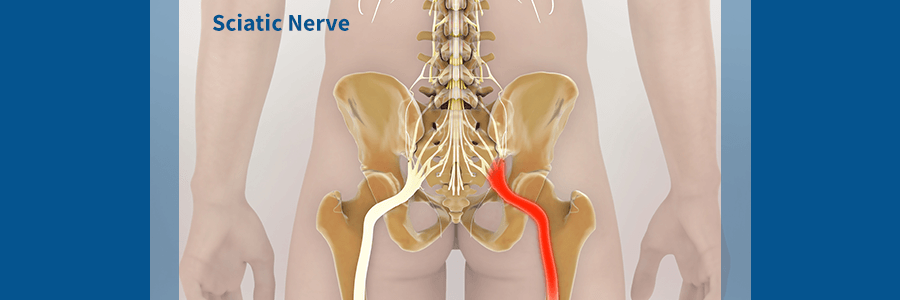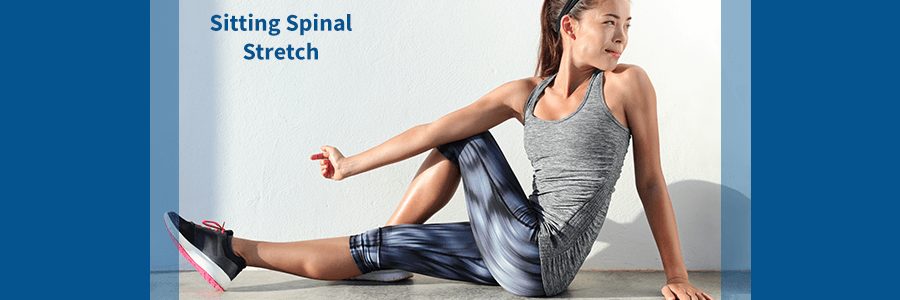Sciatica Stretches for Pain Relief

Sciatica is a medical condition that causes pain to radiate from the lower back down through the hips, buttocks, and legs. However, in the vast majority of cases, the condition only affects one side of the body (known as unilateral pain).
Sciatica normally occurs as a direct result of some other problem, such as a lumbar herniated disc, bone spurs, or lumbar spinal stenosis. The common thread here is that in some way or another, the space surrounding the sciatic nerve dwindles, leading to nerve compression. This is what causes the painful symptoms of the condition. In addition, patients may also experience inflammation and numbness in the affected leg.
The pain of sciatica may be quite severe in many cases. Although this may be, a lot of sciatica patients find that their condition resolves with non-operative treatments in a few weeks time. That being said, this does not account for 100% of all cases. There is always a more severe form of the condition, which may require surgical intervention. For sciatica, this usually refers to patients with significant leg weakness and/or loss of bowel/bladder control. If you have any of those symptoms, then seek medical consultation immediately. These symptoms may be a sign of something much more serious, like cauda equina syndrome.

How Do I Know If I Have Sciatica?
The most common symptom of sciatica is pain that radiates from the lumbar spine down to the buttock and leg. That being said, discomfort may be felt at any point along the sciatic nerve pathway. However, the pain is most likely to follow a path from the lower back to the buttock and into the backside of the thigh and calf.
The sensations of pain for this condition vary widely, from mild discomfort to sharp aches. Sometimes, patients describe the pain as an excruciating burning sensation. In other instances, the pain may even feel like a jolt or an electric shock. These painful sensations may be exacerbated when you cough or sneeze, and prolonged sitting may make symptoms even more severe.
A small number of patients also experience numbness and muscle weakness in the affected leg or foot. These symptoms may exist simultaneously with the pain (having one part of the leg feel numb and experiencing pain in another region). If you experience any weakness in the leg or a loss of bladder/bowel control, then remember to contact a doctor as soon as possible. This may be a sign that you require emergency surgery for your condition.
Pain Relieving Stretches for Sciatica
The nerve pain from sciatica is sometimes so excruciating that you feel like you can’t even get out of bed. This pain may occur for any number of different reasons. The most important takeaway, however, is that you must try to identify which movements do not hurt. More often than not, the most troublesome areas are the hips and lumbar region. In general terms, the best way to alleviate most sciatica-related pain is to do any stretch that externally rotates the hip to provide relief.
Reclining Pigeon Pose
The pigeon pose is a very popular yoga pose that works by spreading out the hips. There are several different iterations of this stretch, with this being the first variation in the post. If you are just beginning with your sciatica stretching treatment, then this is a great place to start. To perform this stretch, you are going to want to do the following:
- Begin backside down and position the right leg towards the ceiling at a right angle. As you do this, bring both of your hands together behind your thigh while locking the fingers.
- Next, lift the other leg and position your right foot on the upper side of your left knee bone.
- Once you are at this step, hold the pose for a moment.
- Once you have completed the exercise, perform it again but now on the other side of the body.
After you have mastered the reclining version without pain, you may graduate on to other forms of the pigeon pose.
Sitting Pigeon Pose
To perform this stretch, you are going to want to do the following:
- Begin by sitting on the floor with your back straight and your legs positioned out in front of you.
- Start by bending your right leg, while putting your right foot on top of the opposite knee.
- Lean forward and stretch the upper region of your body toward your thigh.
- Hold this pose for 15 to 30 seconds. This stretch is versatile, as it works both the glutes and lumbar region of the back.
- Repeat the exercise again, but on the other side of the body.
Forward Pigeon Pose
To perform this stretch, you are going to want to do the following:
- Begin by kneeling down on all fours.
- Start by moving your right leg forward on the floor towards your abdomen. While you do this, your lower leg should still be on the ground, horizontal with your body. Your right foot should also stay a bit forward of your right knee and your knee should maintain an angle.
- Next, stretch your other leg far out behind you on the ground. During this step, the top of the foot should stay on the ground and you should keep your toes straightened back.
- Follow up by shifting your weight slowly to the legs. Your legs should be supporting your weight during this step. At this point, you are going to want to sit up while moving your hands to the sides of your legs.
- Now, inhale deeply. While you exhale, lean the upper region of your body over your forward leg. During this time, use your arms as a means to pillar the weight of your body as much as you feasibly can.
- Repeat these exercises again, but on the other side of the body.
Sitting Spinal Stretch
Sciatic nerve compression triggers the symptoms of sciatica pain. This stretch will aid in the plight to create space in the spine, thereby lessening the pressure on the sciatic nerve. To perform this stretch, you are going to want to do the following:
- Begin down on the floor in a seated position. Point your legs out in front of your body and point your toes toward the ceiling.
- Next, curve your right knee while placing your foot down on the ground at the exterior side of your left knee.
- After that, position your left elbow on the exterior side of your right knee. Doing so will aid your body to rotate slightly towards the right.
- Hold this pose for 30 seconds. Make sure to repeat this exercise at least three times while switching to different sides of the body.

Standing Hamstring Stretch
This stretch will help ease negative symptoms in your hamstrings. To perform this stretch, you are going to want to do the following:
- Position your right foot on a surface that is at most hip height. It doesn’t matter how you do this, but many accomplish this using a chair, ottoman, or step on a flight of stairs. During this step, you want to make sure to keep your leg and toes in line. If your knee has a propensity to hyperextend, be sure to keep a gentle curve to it.
- After that, curve your body towards the extended leg. You can go as deep as you like here, just don’t overdo it.
- Make sure to relax the hip of the leg sticking up in the air. If you need help during this step, consider using accessories such as a yoga strap or exercise band to help you complete the exercise.
- Hold this pose for roughly 30 seconds and then do it again on the opposite side of the body.
Contact Us
If these stretches do not provide adequate relief for your sciatica, please contact our practice at (855) 210-0899. Dr. Daveed Frazier is a respected expert in the field of pain relief with over two decades of experience. Behind him is a dedicated team of professionals who are passionate about putting you on a care plan that suits your specific needs. Don’t hesitate and let your condition become worse. Contact us today!
